
PREV ARTICLE
NEXT ARTICLE
FULL ISSUE
PREV FULL ISSUE
THE 1797 RECOINING PROGRAM OF CZAR PAUL I OF RUSSIA
Steve Bishop submitted this article on the 1797 recoining program of Czar Paul I of Russia. Thanks! -Editor
BACKGROUND
There are a few reasons why these overstrikings occurred. The lack of new planchets was one possible reason, although, considering the vast reserves of copper in Russia at the time, this was probably not significant. Another reason might have been royal jealousy. Many Catherine II 5 kopeck pieces were struck over 5 kopeck pieces of Elizabeth (1741-1761), which might have been Catherine’s way of eradicating the memory of her previously longest reigning predecessor other than Peter I. The most predominant reason for overstriking is also the most logical: a change in the monetary standard. The first overstrikings under Anna Ivanovna started in 1730 when she changed the copper coin standard from 40 rubles to 1 pood of copper to the new standard of 10 robles to 1 pood of copper. (A pood is a unit of mass equal to 40 funt (фунт, Russian pound). Plural: pudi or pudy. It is approximately 16.38 kilograms (36.11 pounds)). Old Peter I kopecks, cruciform 1-kopecks, dengas (1/2 kopeck) and polushkas (1/4 kopeck) were redeemed and withdrawn from circulation. They were recoined into dengas and polushkas of the new standard according to their weight, or got melted at the Mints. This practice continued under subsequent rulers as monetary standards fluctuated. The scarcity of the coins of Peter III (1762) derive not only from the shortness of his reign (a mere 6 months), but also from Catherine II changing the monetary standard back to the 16 rubles to the pood that had existed under Elizabeth, but had been changed to 32 rubles to the pood by Peter III. This change prompted Catherine to recoin most of the 10 kopeck and 4 kopeck pieces minted by Peter into 5 and 2 kopeck pieces, respectively. THE 1797 RECOINING PROGRAM OF PAUL I
Paul, as crown prince, had opposed the changing of the monetary standard in 1796, but had been overruled by his mother. With his ascension to Czar after Catherine’s death, he promptly reversed his mother’s decision and changed the monetary standard back to 16 rubles to the pood. The problem was that 2,378,400 rubles worth of the newly minted Cipher coins remained. Paul’s solution was tried and true: he either melted the earlier coinage or restruck them back into denominations corresponding to the desired monetary standard. His decision was controversial, and, as B.F. Brekke states that “… in order to put the blame squarely on the shoulders of the ‘previous administration,’ the about 2 million rubles worth of lightweight coins was to be overstruck with Catherine’s design!” Three denominations were produced, ranging from scarce to unique. Only one 1 Kopeck piece is known, dated 1793 with the mintmark EM (Ekaterinberg), and is housed in the Hermitage Museum in St. Petersburg. Three scarce to rare varieties of 2 Kopeck pieces were struck, dated 1793 EM, and one extremely rare, possibly unique, variety dated 1796 AM (Annensk). 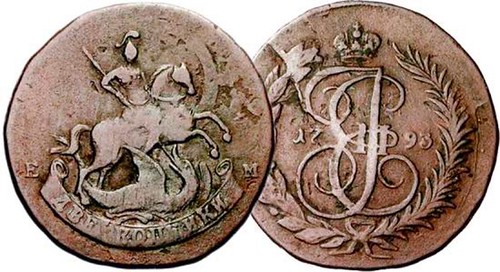
2 KOPECK PIECE DATED 1793 EM OVERSTRUCK IN 1797 BY CZAR PAUL I The recoining program was carried out at a total of 5 mints, Ekaterinberg, Annensk, St. Petersburg, Moscow, and Moscow’s branch, Nizhny Novgorod. There are, however, only three mintmark varieties to be found: no mintmark, AM, and the most common, EM. Five different dates were produced of the most common denomination, 5 Kopecks, and they range from scarce to extremely rare. 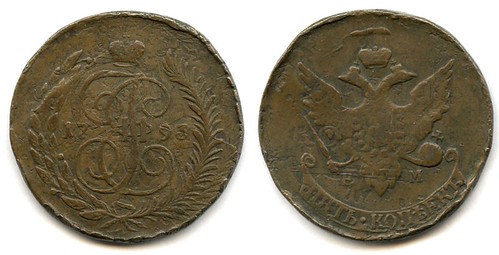
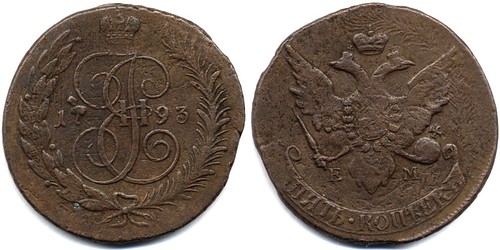
5 KOPECK PIECES DATED 1793 EM RESTRUCK IN 1797 BY CZAR PAUL I 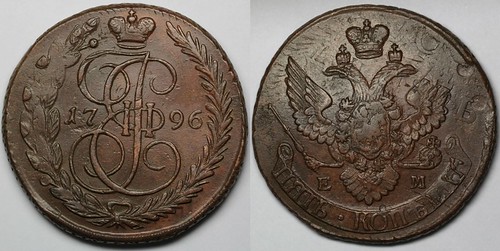
5 KOPECK PIECE DATED 1796 EM RESTRUCK IN 1797 BY CZAR PAUL I It is usually not difficult to discern the coins from Paul’s recoining program from coins that were overstruck by Catherine or coins of the same date. Firstly, if the coin shows signs of overstriking, and is dated 1791, 1793, 1794, 1795, or 1796, it is a product of the 1797 recoining program, as no coins were originally overstruck in those years. Secondly, most of the recoined pieces, since they have been overstruck at least twice, are wide and thinner than the typical 5 Kopeck coin of Catherine II, and typically exhibit a lack of detail in the designs. In fact, it is theoretically possible that such a coin may have been struck a total of five times! Here is the possible sequence: a 5 Kopeck piece of Elizabeth, restruck as a 10 Kopeck piece in 1762 by Peter III, restruck again as a 5 Kopeck piece by Catherine II ca. 1763-89, restruck a third time as a 10 Kopeck piece of the Cipher design in 1796, and restruck a fourth time as a 5 Kopeck piece of the usual Catherine II design in 1797 by Paul I. (Can you imagine how one of these coins would feel? “Oh, come on! Make up your mind, already!). Obviously, this would be difficult to confirm, as traces of earlier overstriking would have been obliterated by later ones, and thus the third way of discerning coins from the 1797 recoining program is by identifying traces of the 1796 Cipher design under the Catherine II 5 Kopeck design. The most telling clue is remnants of the distinctive dots of the Cipher design. Other prominent traces also found are remains of the large script “E”, the 1796 date, and the denomination inscription. In conclusion, the coins resulting from the 1797 recoining program of Czar Paul I stand out among other overstruck Russian coins of the 18th century by virtue of their unique physical characteristics and their historical circumstances. It is this distinctiveness that drives my interest in them and compels me to acquire as many of these unusual coins as I can, if they are available at a reasonable price. (NOTE: This article was derived extensively from material found in The Copper Coinage of Imperial Russia, 1700-1917, by B.F Brekke, and the article “XVIII Century Copper "Overstrikes": from Peter the Great Cruciform 5-Kopecks to 2-Kopecks of Paul’s Recoining with Ekaterina II Monogram Dies”, by Eugene Skobtchenko, first published in the “Petersburg Collector” (Питербургский Коллекционер) in 2014.) 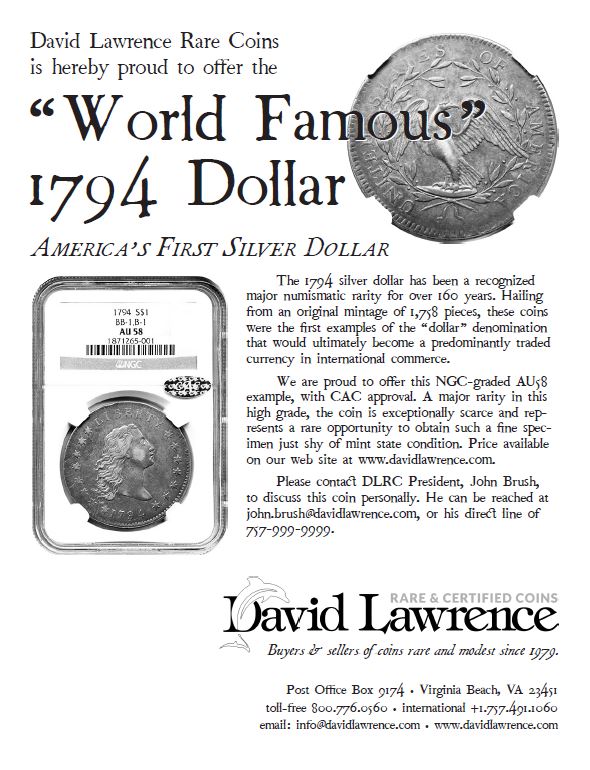
Wayne Homren, Editor The Numismatic Bibliomania Society is a non-profit organization promoting numismatic literature. See our web site at coinbooks.org. To submit items for publication in The E-Sylum, write to the Editor at this address: whomren@gmail.com To subscribe go to: https://my.binhost.com/lists/listinfo/esylum All Rights Reserved. NBS Home Page Contact the NBS webmaster 
|